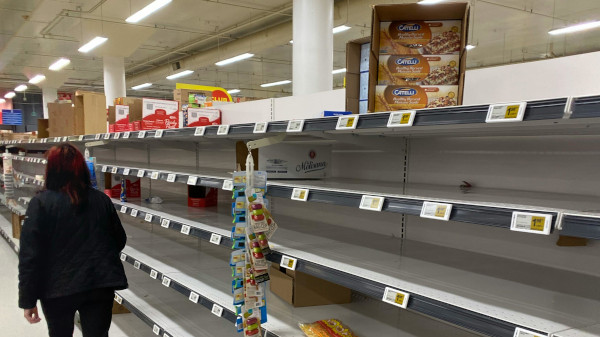Editor’s Note: The SCM capstone Case Fill Rate Prediction was authored by Madeleine Lee and Kamran Iqbal Siddiqui, and supervised by Dr. Elenna Dugundji ([email protected]) and Dr. Thomas Koch ([email protected]). For more information on the capstone, please contact the thesis supervisors.
The fast-moving consumer goods (FMCG) industry, currently valued at $10 trillion, is poised for exponential growth, projected to reach $15 trillion by 2025. However, the industry’s complex supply chains and unpredictable demand patterns have been further complicated by recent disruptions such as the COVID-19 pandemic, the Suez Canal blockade, and port congestion. These challenges have highlighted the vulnerability of the FMCG sector, leading to unmet customer demands and jeopardizing business resilience.
To address these issues, our capstone project set out to identify the key factors contributing to low case fill rates (CFR) in an FMCG company and develop predictive models to improve future CFR. By harnessing data-driven insights, this project offers a transformative approach to managing CFR, ultimately enhancing sales, customer loyalty, and overall resilience within the FMCG landscape.
Common struggles
Consumer product companies, with diverse product portfolios, face the common struggle of maintaining optimal CFR in a dynamic business environment. CFR, calculated by dividing total shipments by total customer orders, serves as an indicator of a company’s ability to fulfill customer demands. A decline in CFR can result in lost sales, eroded customer loyalty, and even potential contract breaches. As little as a 1% drop in sales can translate into millions in lost net profit margin, underscoring the criticality of maintaining an optimal CFR.
Our project followed a robust three-phase methodology: business understanding, modeling, and validation. Extensive datasets, including sales transactions, customer purchase history, inventory levels, and manufacturing plans, were compiled to gain a holistic understanding of business operations and customer behavior. Rigorous data preprocessing techniques were employed to ensure data integrity, integrate diverse datatypes, and enhance data quality. And descriptive analytics, such as ACF (autocorrelation function) and PACF (partial autocorrelation function), were applied to identify autocorrelation in the time series dataset.
In the modeling phase, various techniques were employed to uncover patterns and forecast future CFR. Time series analysis enabled the isolation of the impact of single and multiple variables on CFR. Statistical methods, including decision tree matrices, were utilized to identify major drivers of low CFR. Two distinct approaches were taken: a hybrid model to predict cut quantities and, to forecast inventory availability and order quantity, advanced deep learning techniques, including XGBoost, LSTM, and multistep LSTM.
Improving forecast accuracy
The project yielded valuable insights into the factors influencing CFR. It was found that forecast accuracy and demand variability were the primary drivers impacting CFR. Inaccuracies between predicted and actual customer demands significantly influenced the CFR, underscoring the importance of improving forecast accuracy and maintaining adequate inventory levels.
The hybrid model, incorporating logistic regression, random forest regression, and support vector machine (SVM), demonstrated impressive precision and accuracy in predicting cut quantities and CFR. In the second approach, advanced time series machine learning models like XGBoost, LSTM, and multi-step-LSTM showed potential for short-term forecasting. While long-term predictions posed challenges, these models provided valuable insights for inventory optimization.
The project's findings hold immense significance for the FMCG industry. By identifying forecast error and demand variability as critical factors impacting CFR, the project highlights the need for improved forecast accuracy and inventory optimization. Integrating exogenous factors, such as promotions and market indices, into forecasting models can further enhance accuracy and reliability.
Though challenges remain, such as inventory variability and irregular order patterns, the project lays a strong foundation for future research. Employing a combination of machine learning and deep learning techniques, exploring reinforcement learning, and incorporating additional data inputs like promotional activities and competitor pricing can lead to superior predictive accuracy. By adopting these data-driven insights, FMCG companies can proactively mitigate stockouts, enhance CFR, and thrive in an ever-changing business landscape.
Every year, approximately 80 students in the MIT Center for Transportation & Logistics’s (MIT CTL) Master of Supply Chain Management (SCM) program complete approximately 45 one-year research projects.
These students are early-career business professionals from multiple countries, with two to 10 years of experience in the industry. Most of the research projects are chosen, sponsored by, and carried out in collaboration with multinational corporations. Joint teams that include MIT SCM students and MIT CTL faculty work on real-world problems. In this series, they summarize a selection of the latest SCM research.
SC
MR


More Resilience
- World Trade Centers offers a helping hand to create resilient, interconnected supply chains
- Investor expectations influencing supply chain decision-making
- Predicting stockouts: Enhancing FMCG resilience through data-driven insights
- More complex trade-offs are necessary to maintain a high-performing supply chain
- Dun & Bradstreet Finds Most Supply Chains are Underprepared for Big Disruptions
- More Resilience
 Explore
Explore
Topics
Procurement & Sourcing News
- AI-driven sourcing: Why the speed of change is going to only accelerate
- A Silk Road city
- U.S.-bound containerized import shipments are up in June and first half of 2024
- Boeing turned to Fairmarkit, AI to help land its tail spend
- When disaster strikes, the supply chain becomes the key to life
- A smarter approach to sustainability is vital for healthy, resilient supply chains
- More Procurement & Sourcing
Latest Procurement & Sourcing Resources

Subscribe

Supply Chain Management Review delivers the best industry content.

Editors’ Picks




